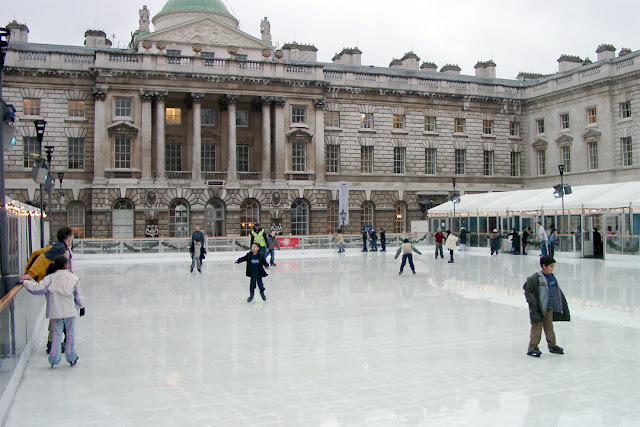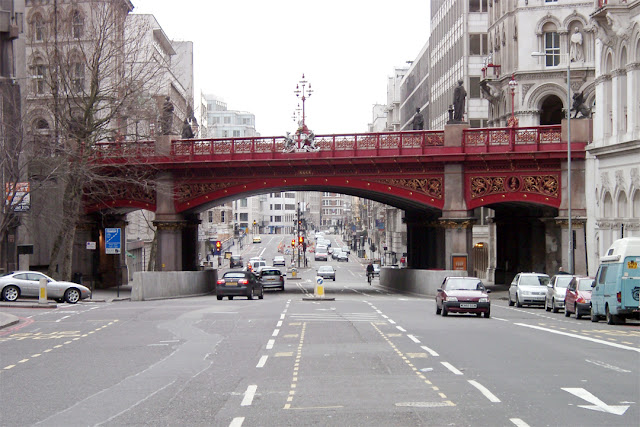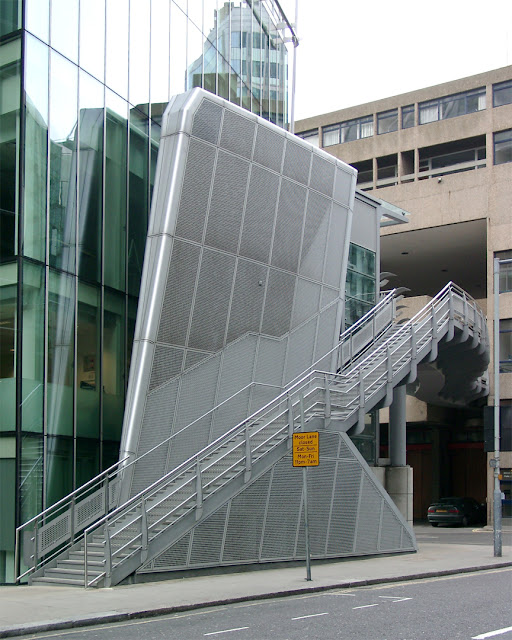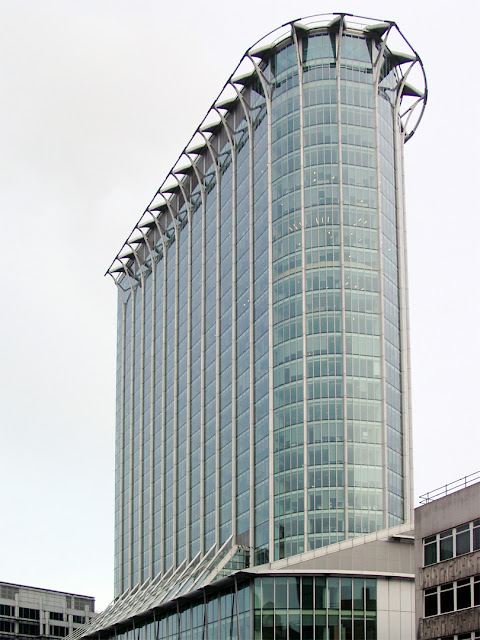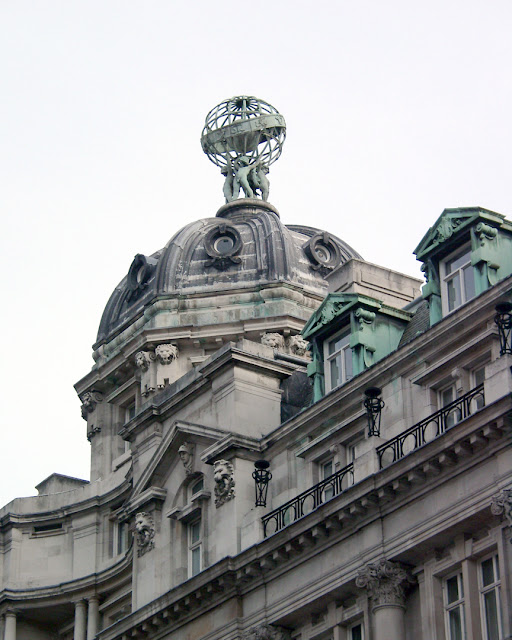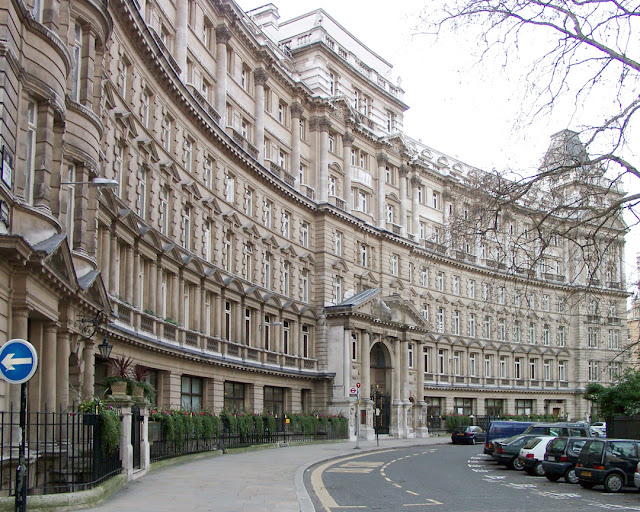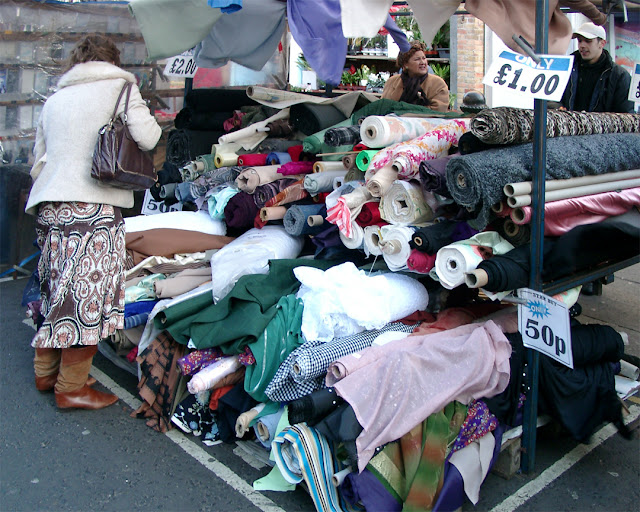Monday, October 31, 2005
Somerset House ice rink
Somerset House ice rink
Strand
London, January 2005
“In the winter the central courtyard is home to a popular open-air ice rink, as seen during the opening credits of the 2003 Christmas-themed film Love Actually. At other times, an array of fountains display 55 vertical jets of water rising to random heights.” (Somerset House, Wikipedia)
Sunday, October 30, 2005
Holborn Viaduct
Holborn Viaduct
Holborn
London, January 2005
“Holborn Viaduct is a road bridge in London and the name of the street which crosses it (which forms part of the A40 route). It links Holborn, via Holborn Circus, with Newgate Street, in the City of London financial district, passing over Farringdon Street and the subterranean River Fleet. The viaduct spans the steep-sided Holborn Hill and the River Fleet valley at a length of 1,400 feet (430 m) and 80 feet (24 m) wide. City surveyor William Haywood was the architect and the engineer was Rowland Mason Ordish.” (Holborn Viaduct, Wikipedia)
Saturday, October 29, 2005
Smithfield Meat Market
Smithfield Meat Market
Grand Avenue, Farringdon
City of London
London, January 2005
“Smithfield is the City of London's only major wholesale market (Leadenhall Market nowadays attracts more tourist trade)[63] which has escaped relocation out of central London to cheaper land, better transport links, and more modern facilities. (Covent Garden, Spitalfields and Billingsgate have all relocated). The market operates to supply inner City butchers, shops and restaurants with quality fresh meat, and so its main trading hours are 4:00 a.m. to 12:00 noon each weekday.[37] Instead of moving away, Smithfield Market continues to modernise its existing site: its imposing Victorian buildings have had access points added for the loading and unloading of lorries. The buildings stand above a warren of tunnels: previously, live animals were brought to market by hoof (from the mid-19th century onwards they arrived by rail) and were slaughtered on site. The former railway tunnels are now used for storage, parking and as basements. An impressive cobbled ramp spirals down around West Smithfield's public garden, on the south side of the Market, providing access to part of this area. Some of the buildings on Charterhouse Street on Smithfield north side maintain access to the tunnels via their basements.” (Smithfield, Wikipedia)
Friday, October 28, 2005
Barbican Centre
Barbican Centre
Silk Street, Barbican
City of London
London, January 2005
“The Barbican Centre is a performing arts centre in the Barbican Estate of the City of London and the largest of its kind in Europe. The centre hosts classical and contemporary music concerts, theatre performances, film screenings and art exhibitions. It also houses a library, three restaurants, and a conservatory. The Barbican Centre is member of the Global Cultural Districts Network. The London Symphony Orchestra and the BBC Symphony Orchestra are based in the centre's Concert Hall. In 2013, it once again became the London-based venue of the Royal Shakespeare Company following the company's departure in 2001. The Barbican Centre is owned, funded, and managed by the City of London Corporation, the third-largest arts funder in the United Kingdom. It was built as The city's gift to the nation at a cost of £161 million (equivalent to £480 million in 2014) and was officially opened to the public by Queen Elizabeth II on 3 March 1982. The Barbican Centre is also known for its brutalist architecture.” (Barbican Centre, Wikipedia)
Thursday, October 27, 2005
Wednesday, October 26, 2005
Tuesday, October 25, 2005
Monday, October 24, 2005
Sunday, October 23, 2005
Citypoint
Citypoint, 1967
Ropemaker Street
City of London
London, January 2005
“Citypoint (previously known as Britannic House and Britannic Tower) is a skyscraper located on Ropemaker Street on the northern fringe of the City of London, the main financial district and historic nucleus of London. Originally named Britannic House, Citypoint was built in 1967 as a 35-storey, 122 metres (400 ft) tall headquarters for British Petroleum (now BP), becoming the first building in the City of London area to exceed the height of St Paul's Cathedral. The designers were F. Milton Cashmore and H. N. W. Grosvenor. In 1991 British Petroleum moved back to their original headquarters on Finsbury Circus and the building was renamed Britannic Tower. It was refurbished in 2000, with additional floor space and the height increased to 127 metres (417 ft). The designer for the refurbishment was Sheppard Robson. It was renamed Citypoint after its refurbishment.” (Citypoint, Wikipedia)
Saturday, October 22, 2005
St Alphage Garden
St Alphage Garden London Wall, City of London London, January 2005
“St Alphage Garden is an urban garden in the City of London, off London Wall. It was converted from the former churchyard of St Alphage London Wall in 1872. The north edge of the garden is defined by a section of the ancient London Wall. A lowered, paved extension to the garden lies to the west, accessed by a gate and a flight of steps. Both sections of the garden hold flower beds and benches. The main garden is mostly grass, with a magnolia tree and an oak tree. The southern edge of the garden is defined by a beech hedge. On the other side of the Wall lies the private Salters' Garden.” (St Alphage Garden, Wikipedia)
Friday, October 21, 2005
Moor House
Moor House by Foster + Partners, 2004
London Wall
City of London
London, January 2005
“Moor House is a large office building on London Wall in the City of London. It is located on the northern edge of the financial district and is one of the largest buildings in the area, standing 84 metres (276 ft) tall and with 29,000 square metres of floor space. Completed in 2004, it was the first building to be designed for the forthcoming Crossrail, with a ventilation shaft to the station underneath the building. When built, it had the deepest foundations in London, which reach down 57 metres (187 ft) and are specifically designed to withstand further tunneling below it in the future. The building cost £182 million to construct and was designed by Sir Norman Foster.[1] Tenants include CLSA, Unicredit, Peel Hunt, TT International.” (Moor House, Wikipedia)
Thursday, October 20, 2005
Electra House
Young Atlases supporting a zodiacal globe by F.W. Pomeroy, 1902
Electra House
Moorgate, City of London
London, January 2005
“Architect John Belcher designed the building, which opened in 1902 as accommodation for the Eastern Telegraph Company. On 11 May 1933, the company transferred administrative functions to a new Electra House building on Victoria Embankment. This became the administrative headquarters for the renamed Imperial and International Communications, which became Cable & Wireless Limited in 1934. The Foreign Office created a propaganda organisation known as Department EH, after its headquarters Electra House. Department EH was involved in the monitoring of foreign embassy communications, and cabling run between both buildings ensured continuance of this service even following direct bomb damage during World War II. The remaining Cable & Wireless operations were finally moved from the Moorgate building to Victoria Embankment when the original building suffered severe bomb damage during the World War II. Electra House (Victoria Embankment) was itself subsequently hit by a V-1 flying bomb in July 1944, but this resulted in only three[3] fatalities among the 400 attending staff and did not stop daily operations. Electra House continued to be a hub for telecommunications activities by its eventual owners, BT Group, until its final demolition and replacement by a new building, now occupied by British American Tobacco. The Electra House Retired Colleagues Association, formed from staff of Electra House (Victoria Embankment) and other BT Group offices, continue to stay in contact and meet. Following its repair from bomb damage, City of London College moved into Electra House in 1944 and still occupies the building, although it is now known as London Metropolitan University.” (Electra House, Wikipedia)
Wednesday, October 19, 2005
Tuesday, October 18, 2005
Finsbury Circus
Corner with former East Street
Finsbury Circus
City of London
London, January 2005
“Finsbury Circus is a park in the Coleman Street Ward of the City of London, England. The 2.2 hectares park is the largest public open space within the City's boundaries. It is not to be confused with Finsbury Square, just north of the City, or Finsbury Park, a few miles away.” (Finsbury Circus, Wikipedia)
Monday, October 17, 2005
Sunday, October 16, 2005
Leaping Hare
Leaping Hare on Crescent and Bell by Barry Flanagan, 1988
Broadgate Circle
Broadgate, City of London
London, January 2005
“In 1979, artist and sculptor Barry Flanagan bought a hare from his local butcher’s (his friend Peter Randall-Page thinks he may even have found it lying by the side of the road) and an art legend was born. Recreating its form became the inspiration for many of Flanagan’s long-limbed exuberant creations (he even playfully substituted a hare for Rodin’s famous The Thinker in his 1997 piece, Thinker On The Rock), which in turn became a sought-after collectors’ pieces. At Broadgate Circle, Flanagan’s gravity-defying hare energises and lifts the spirit, bounding over the narrow crescent and the weighty dome of the bell. Exuding an air of playfulness, the sculpture conveys Flanagan’s interest in mythology with the hare (long-associated with constellations, the Chinese believe the hare is the sole inhabitant of the moon) leaping over a moon crescent. While the bell dome is present – a symbol of steadfast solidity and settled communities – it’s the madcap hare who takes centre stage; a spirit of anarchy that Flanagan himself deftly encouraged, ‘People ask me all the time why I make sculptures of rabbits.’” (Leaping Hare on Crescent and Bell, Broadgate)
Saturday, October 15, 2005
St Ethelburga's Bishopsgate
St Ethelburga's Bishopsgate
Bishopsgate
City of London
London, January 2005
“St Ethelburga-the-Virgin within Bishopsgate is a Church of England church in the City of London, located on Bishopsgate near Liverpool Street station. The church was severely damaged by an IRA bomb in 1993. Following rebuilding and restoration it re-opened as a Centre for Reconciliation and Peace.” (St Ethelburga's Bishopsgate, Wikipedia)
Friday, October 14, 2005
Thursday, October 13, 2005
Holland House
Holland House by Hendrik Petrus Berlage, 1916
Bury Street
City of London
London, January 2005
“The Müllers commissioned prominent Dutch architect Hendrik Petrus Berlage (1856-1934) to design an office block for their London base. Berlage is known as the ‘father of Modern architecture’ in his native Holland and is responsible for the Beurs van Berlage (Amsterdam Commodities Exchange) and the Swissôtel Amsterdam. By the time construction started in 1914, World War I had begun, however building wasn’t affected as the Netherlands were neutral. When designing Holland House, it is believed Berlage took inspiration from the works of pioneering American architect Louis Sullivan (1856-1924), following a trip to the US in 1911.” (Holland House, Memoirs of a Metro Girl)
Wednesday, October 12, 2005
St Helen's Bishopsgate
St Helen's Bishopsgate
Great St Helen's
City of London
London, January 2005
“St Helen's Bishopsgate is an Anglican church in London. It is located in Great St Helen's, off Bishopsgate. It is the largest surviving parish church in the City of London. Several notable figures are buried there, and it contains more monuments than any other church in Greater London except Westminster Abbey, hence it is sometimes referred to as the "Westminster Abbey of the City". It was the parish church of William Shakespeare when he lived in the area in the 1590s. It was one of only a few churches in the City of London to survive both the Great Fire of 1666 and the Blitz.” (St Helen's Church, Wikipedia)
Tuesday, October 11, 2005
99 Bishopsgate
99 Bishopsgate, 1976
Bishopsgate
City of London
London, January 2005
“99 Bishopsgate is a commercial skyscraper in London. It is located on Bishopsgate, a major thoroughfare in the City of London financial district. The building is 104 metres (341 ft) tall and has 25 office floors, with a total net lettable floor space of circa 30,000 square metres (322,900 sq ft). There are a further three plant floors at levels LG, 14 and 27. The original core and steelwork was completed in 1976. At the time, it had the fastest lifts in Europe, running at up to 6.5 metres per second. The building was occupied solely by the Hong Kong and Shanghai Banking Corporation (HSBC) until the organisation moved to 8 Canada Square at Canary Wharf (that building subsequently became known as the HSBC Tower). 99 Bishopsgate was extensively damaged in 1993 by a truck bomb exploded by the Provisional IRA, which also damaged the neighbouring Tower 42. The building was fully refurbished over a period of 14 months, which resulted in substantially improved cladding and a façade overrun which increased its overall height slightly. Larger, open plan floorplates were also created. It re-opened in mid-1995 as a multi-let office tower and is currently owned (leasehold) by Hammerson and managed by CBRE Group.” (99 Bishopsgate, Wikipedia)
Monday, October 10, 2005
St Botolph-without-Bishopsgate
St Botolph-without-Bishopsgate
Bishopsgate
City of London
London, January 2005
“St Botolph-without-Bishopsgate is a Church of England church in the Bishopsgate Without area of the City of London, and also, by virtue of lying outside the City's (now demolished) eastern walls, part of London's East End. Adjoining the buildings is a substantial churchyard – running along the back of Wormwood Street, the former course of London Wall – and a former school. The church is linked with the Worshipful Company of Coopers and the Worshipful Company of Bowyers.” (St Botolph-without-Bishopsgate, Wikipedia)
Sunday, October 9, 2005
Saturday, October 8, 2005
Time Flies
“Time Flies” clock tower and drinking fountain, 1909
Broad Walk
Kensington Gardens
London, January 2005
Friday, October 7, 2005
Thursday, October 6, 2005
Wednesday, October 5, 2005
Tuesday, October 4, 2005
Monday, October 3, 2005
Sunday, October 2, 2005
Saturday, October 1, 2005
Milk chocolate slims
Pyramids of milk chocolate slims
British Museum
Great Russell Street, Bloomsbury
London, January 2005
Subscribe to:
Posts (Atom)

